Development of a Convolution-Based Multi-Directional and Parallel Ant Colony Algorithm Considering a Network with Dynamic Topology Changes
Abstract
1. Introduction
2. Background Knowledge
2.1. Routing Generation Methods and Ant Colony Optimization
2.2. Gaussian Processes Regression
3. Multi-Directional and Parallel Ant Colony Optimization (MPACO)
| Algorithm 1. Route search algorithm for detecting a collision node. |
| Initialize: Current iteration→ Overall number of agents → for k=1 to Ants start from node and node ( node has ants, and node has ants). Choose the next node using a . (Equation (1)) end for When ants in different groups meet in a node, it is classified as a collision node (q). If (the existence of q == false) Go to Algorithm 2. else Go to Algorithm 3. end if |
| Algorithm 2. Route search in the case of the non-existence of a “collision node”. |
| Initialize: Evaporation rate The objective function is to minimize the distance of the route where the ants are moved (Equation (2)). Combine the distances moved in each section. Choose the optimal candidate route (Equation (3)). Evaporate the pheromones (Equation (5)). Update the pheromones on route (Equation (6)). return Algorithm 1 |
| Algorithm 3. GPR based Pheromone renewal Algorithm. |
| Initialize: Radius w In the q node, all nodes in the radius w = Y = the pheromone values of the . Input: Training data point { , } GPR is applied to predict test data and (Equation (18)). Update pheromone with value on node. Choose the node with the highest pheromone value (Equation (19)). Go to Algorithm 4. |
| Algorithm 4. Route generation Algorithm with an intermediate node (). |
| Initialize: Current iteration→ int+1 number of → v for k=1 to AN/v Ants start from all nodes that are detected. Choose the next node using (Equation (1)). end for |
4. Dynamic Configurable Network and Convolution-Type Multi-Directional and Parallel Ant Colony Optimization (CMPACO)
5. Numerical Studies and Performance Analysis of MPACO and CMPACO
5.1. Performance Comparisons of MPACO and ACO
5.2. Performance Analyses of CMPACO Considering Dynamic Network Topology
6. Conclusions and Further Studies
Author Contributions
Funding
Conflicts of Interest
References
- Dorigo, M.; Maniezzo, V.; Colorni, A. The ant system: Optimization by a colony of cooperating agents. IEEE Trans. Syst. Man Cybern. Part B 1996, 26, 29–41. [Google Scholar] [CrossRef] [PubMed]
- Liu, Y.; Xiao, Y. Parallel solution of maze optimal path based on ant colony algorithm. In Proceedings of the 2nd International Conference on Computer Science and Electronics Engineering, Paris, France, 22–23 March 2013; pp. 1826–1829. [Google Scholar] [CrossRef][Green Version]
- Yan, Z.; Yuan, C.W. Ant Colony Optimization for Navigating Complex Labyrinths. In Proceedings of the International Workshop on Rough Sets, Fuzzy Sets, Data Mining, and Granular-Soft Computing, Chongqing, China, 26–29 May 2003; pp. 445–448. [Google Scholar] [CrossRef]
- Ilie, S.; Badica, C. Multi-agent approach to distributed ant colony optimization. Sci. Comput. Program. 2013, 78, 762–774. [Google Scholar] [CrossRef]
- Yoshikawa, M.; Nagura, T. Adaptive Ant Colony Optimization Considering Intensification and Diversification. In Proceedings of the International MultiConference of Engineers and Computer Scientists, Hong Kong, China, 18–20 March 2009; pp. 200–203. [Google Scholar]
- Yoshikawa, M.; Otani, K. Ant Colony Optimization Routing Algorithm with Tabu Search. In Proceedings of the International MultiConference of Engineers and Computer Scientists, Hong Kong, China, 17–19 March 2010; pp. 17–19. [Google Scholar]
- Kim, J.; Lee, H. Multi-agent Reinforcement Learning based Evacuation Framework Considering Both Evacuation Time and Crowdedness. J. Korean Inst. Intell. Syst. 2016, 26, 335–342. [Google Scholar]
- Dorigo, M.; Birattari, M. Ant Colony Optimization. In Encyclopedia of Machine Learning, 2010 ed.; Sammut, C., Webb, G.I., Eds.; Science+Business Media: Boston, MA, USA, 2010; pp. 37–40. [Google Scholar] [CrossRef]
- Dorigo, M.; Caro, G.D. Ant colony optimization: A new metaheuristic. In Proceedings of the 1999 Congress on Evolutionary Computation, Washington, DC, USA, 6–9 July 1999; pp. 1470–1477. [Google Scholar] [CrossRef]
- Garcia, A.G.; Tria, L.A.R.; Talampas, M.C.R. Development of an Energy-Efficient Routing Algorithm for Electric Vehicles. In Proceedings of the IEEE Transportation Electrification Conference and Expo, Detroit, MI, USA, 19–21 June 2019; pp. 1–5. [Google Scholar] [CrossRef]
- Quang, P.T.A.; Sanner, J.M.; Morin, C.; Aoul, Y.H. Multi-objective multi-constrained QoS Routing in large-scale networks: A genetic algorithm approach. In Proceedings of the International Conference on Smart Communications in Network Technologies, El Oued, Algeria, 27–31 October 2018; pp. 55–60. [Google Scholar] [CrossRef]
- Yu, X.; Liu, Q.; Liu, Y.; Hu, M.; Zhang, K.; Xiao, R. Uneven clustering routing algorithm based on glowworm swarm optimization. Ad Hoc Netw. 2019, 93, 1–8. [Google Scholar] [CrossRef]
- Xu, Y.; Wang, X.; Sun, T. Heuristic routing algorithm toward scalable distributed generalized assignment problem. Soft Comput. 2018, 22, 845–859. [Google Scholar] [CrossRef]
- Qiu, S.; Zhong, Y.; Luo, X.; Liu, J.; Luo, Y.; Jiang, P. A Relay Routing Algorithm for Remote Concentrated Ammeter Reading Based on Ant Colony Optimization. In Proceedings of the International Conference on Systems Engineering, Sydney, Australia, 18–20 December 2018; pp. 1–8. [Google Scholar] [CrossRef]
- Dorigo, M.; Caro, G.D.; Gambardella, L.M. Ant algorithms for discrete optimization. J. Int. Soc. Artif. Life 1999, 5, 137–172. [Google Scholar] [CrossRef]
- Birattari, M.; Pellegrini, P.; Dorigo, M. On the Invariance of Ant Colony Optimization. IEEE Trans. Evolut. Comput. 2007, 11, 732–742. [Google Scholar] [CrossRef]
- Dorigo, M.; Maniezzo, V.; Colorni, A.; Trubian, M. Ant systems for Job shop scheduling. Belg. J. Oper. Res. Stat. Comput. Sci. 1994, 34, 39–54. [Google Scholar]
- Arnaout, J.; Musa, R.; Rabadi, G. Ant colony optimization algorithm to parallel machine scheduling problem with setups. In Proceedings of the IEEE Conference on Automation Science and Engineering, Arlington, VA, USA, 23–26 August 2008; pp. 578–582. [Google Scholar] [CrossRef]
- Chen, R.; Lo, S.; Wu, C.; Lin, T. An effective ant colony optimization based algorithm for flow shop scheduling. In Proceedings of the IEEE Conference on Soft Computing in Industrial Applications, Muroran, Japan, 25–27 June 2008; pp. 25–27. [Google Scholar] [CrossRef]
- Dorigo, M.; Gambardella, L.M. Ant colony system: A cooperative learning approach to the traveling salesman problem. IEEE Trans. Evol. Comput. 1997, 1, 53–66. [Google Scholar] [CrossRef]
- Oh, E.; Lee, H. Effective Routing Generation Framework using Multi-directional and Parallel Ant Colony Optimization. J. Korean Inst. Intell. Syst. 2018, 28, 523–530. [Google Scholar] [CrossRef]
- Ahmadizar, F.; Barzinpour, F.; Arkat, J. Solving permutation flow shop sequencing using ant colony optimization. In Proceedings of the IEEE International Conference on Industrial Engineering and Engineering Management, Singapore, 2–4 December 2007; pp. 753–757. [Google Scholar] [CrossRef]
- Reza, G.A.; Mahfujur, R.; Abdur, R.; Wail, G.; Abdulmotaleb, E.S. Ant colony-based many-to-one sensory data routing in Wireless Sensor Networks. In Proceedings of the IEEE/ACS International Conference on Computer Systems and Applications, Doha, Qatar, 31 March–4 April 2008; pp. 1005–1010. [Google Scholar] [CrossRef]
- Maniezzo, V.; Colorni, A. The ant system applied to the quadratic assignment problem. IEEE Trans. Knowl. Data Eng. 1999, 11, 769–778. [Google Scholar] [CrossRef]
- Williams, C.K.I.; Rasmussen, C.E. Gaussian Processes for Machine Learning; The MIT Press: London, UK, 2006; pp. 7–128. [Google Scholar]
- Williams, C.K.I.; Rasmussen, C.E. Gaussian Processes for Regression. Adv. Neural Process. Syst. 1996, 8, 514–520. [Google Scholar]
- Rasmussen, C.E. Gaussian Processes in Machine Learning. Adv. Lect. Mach. Learn. 2004, 3176, 63–71. [Google Scholar] [CrossRef]
- Ak, C.; Ergonul, O.; Sencan, I.; Torunoglu, M.A.; Gonen, M. Spatiotemporal prediction of infectious diseases using structured Gaussian processes with application to Crimean-Congo hemorrhagic fever. PLoS Negl. Trop. Dis. 2018, 12, e0006737. [Google Scholar] [CrossRef] [PubMed]
- Luttinen, J.; Ilin, A. Efficient Gaussian process inference for short-scale spatio-temporal modeling. In Proceedings of the 15th International Conference on Artificial Intelligence and Statistics, La Palma, Canary Islands, 21–23 April 2012; pp. 741–750. [Google Scholar]
- Nguyen, D.; Peters, J. Learning Robot Dynamics for Computed Torque Control using Local Gaussian Processes Regression. In Proceedings of the ECSIS Symposium on Learning and Adaptive Behaviors for Robotic Systems, Edinburgh, UK, 6–8 August 2008; pp. 59–64. [Google Scholar] [CrossRef]
- Nguyen, L.; Hu, G.; Spanos, C.J. Spatio-temporal environmental monitoring for smart buildings. In Proceedings of the 13th IEEE International Conference on Control and Automation, Ohrid, Macedonia, 3–6 July 2017; pp. 277–282. [Google Scholar] [CrossRef]
- Chen, N.; Qian, Z.; Meng, X.; Nabney, I.T. Short-term wind power forecasting using Gaussian processes. In Proceedings of the 23rd International Joint Conference on Artificial Intelligence, Beijing, China, 3–9 August 2013; pp. 2790–2796. [Google Scholar]
- Schulz, E.; Speekenbrink, M.; Krause, A. A tutorial on Gaussian process regression: Modelling, exploring, and exploiting functions. J. Math. Psychol. 2017, 85, 1–16. [Google Scholar] [CrossRef]
- Eklund, P.W.; Kirkby, S.; Pollitt, S. A Dynamic Multi-source Dijkstra’s Algorithm for Vehicle Routing. In Proceedings of the IEEE Australian and New Zealand Conference on Intelligent Information Systems, Adelaide, SA, Australia, 18–20 November 1996; pp. 329–333. [Google Scholar] [CrossRef]
- Giralda, D.B.; Rodriguez, M.A.; Pernas, F.J.D.; Higuera, J.F.D.; Ortega, D.G.; Zarzuela, M.M. Intelligent system for dynamic transport fleet management. In Proceedings of the IEEE Conference on Emerging Technologies and Factory Automation, Catania, Italy, 19–22 September 2005; pp. 773–776. [Google Scholar] [CrossRef]
- Noto, M.; Sato, H. A Method for the Shortest Path Search by Extended Dijkstra Algorithm. In Proceedings of the International Conference on Systems, Man and Cybernetics, Nashville, TN, USA, 8–11 October 2000; pp. 2316–2320. [Google Scholar] [CrossRef]
- Moss, F.H.; Segall, A. An Optimal Control Approach to Dynamic Routing in Network. IEEE Trans. Autom. Control 1982, 27, 329–339. [Google Scholar] [CrossRef]
- Cauvery, N.K.; Viswanatha, K.V. Routing in Dynamic Network using Ants and Genetic Algorithm. Int. J. Comput. Sci. Netw. Secur. 2009, 9, 194–200. [Google Scholar]
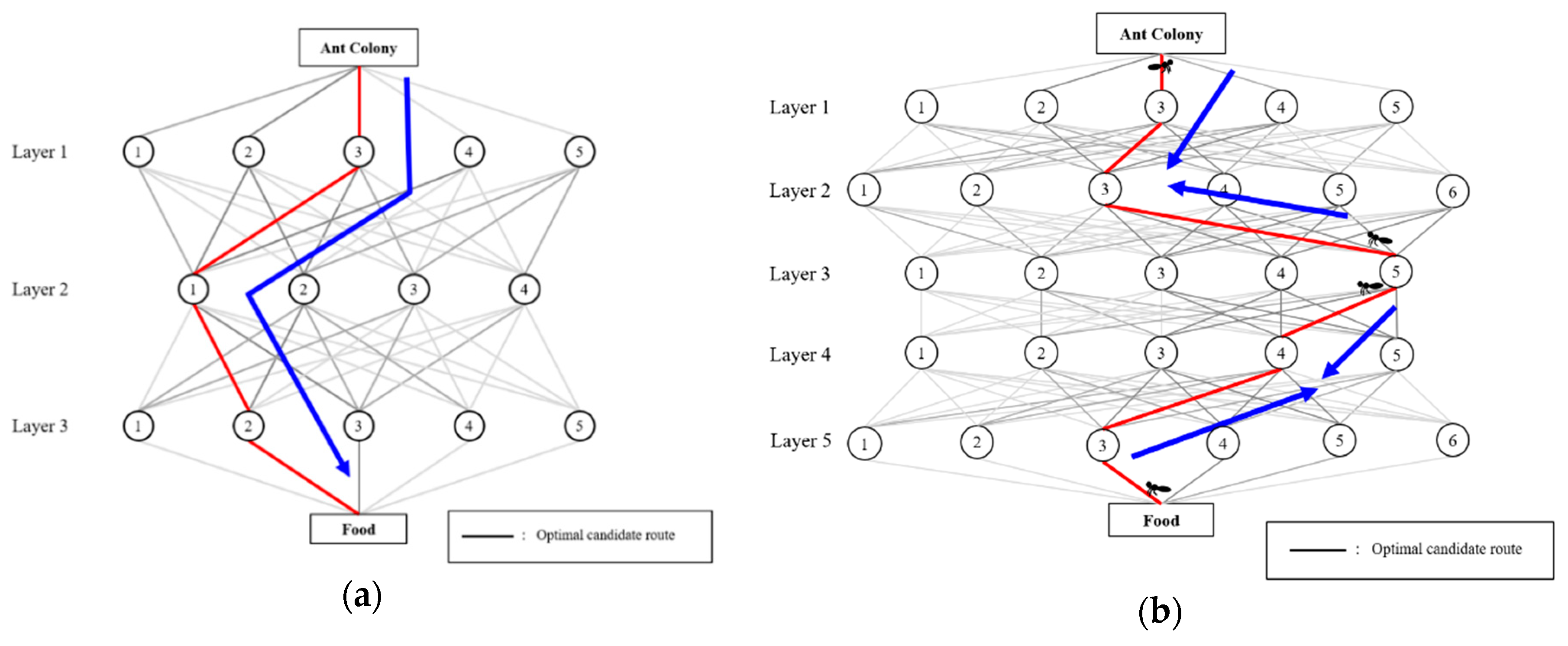
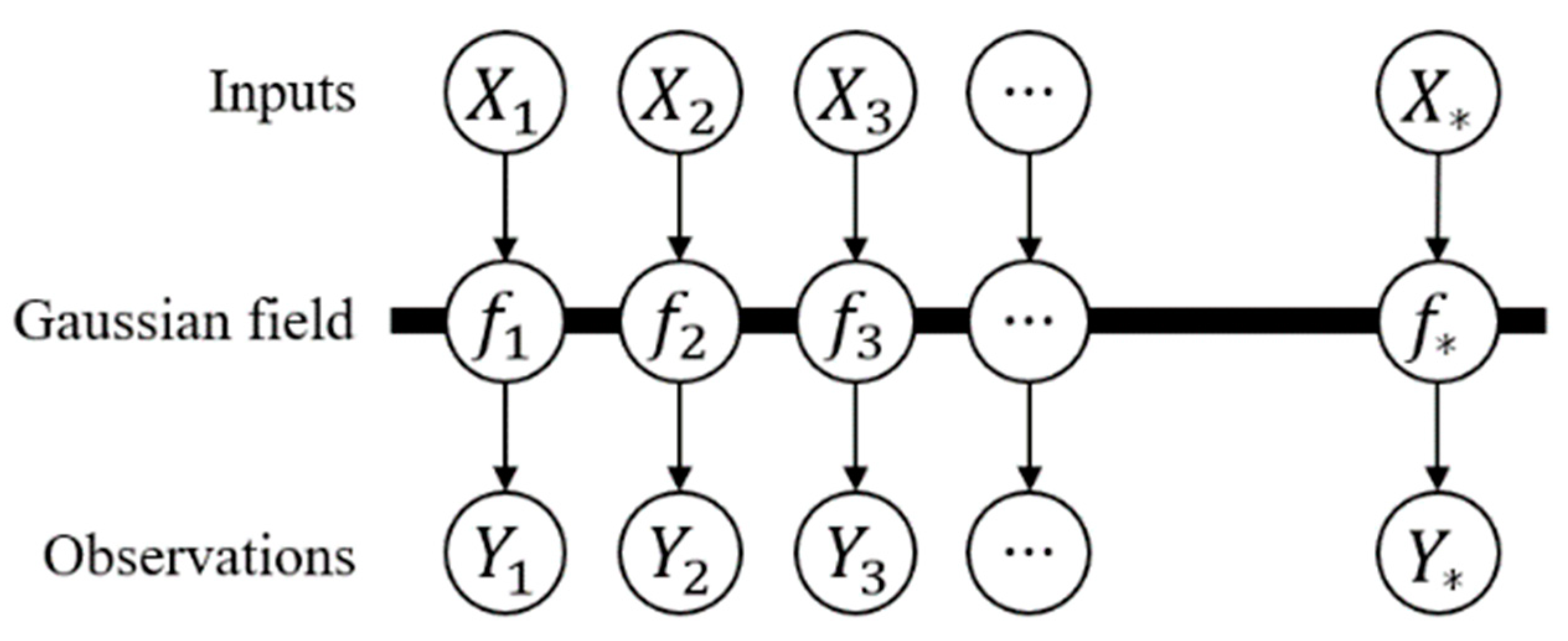
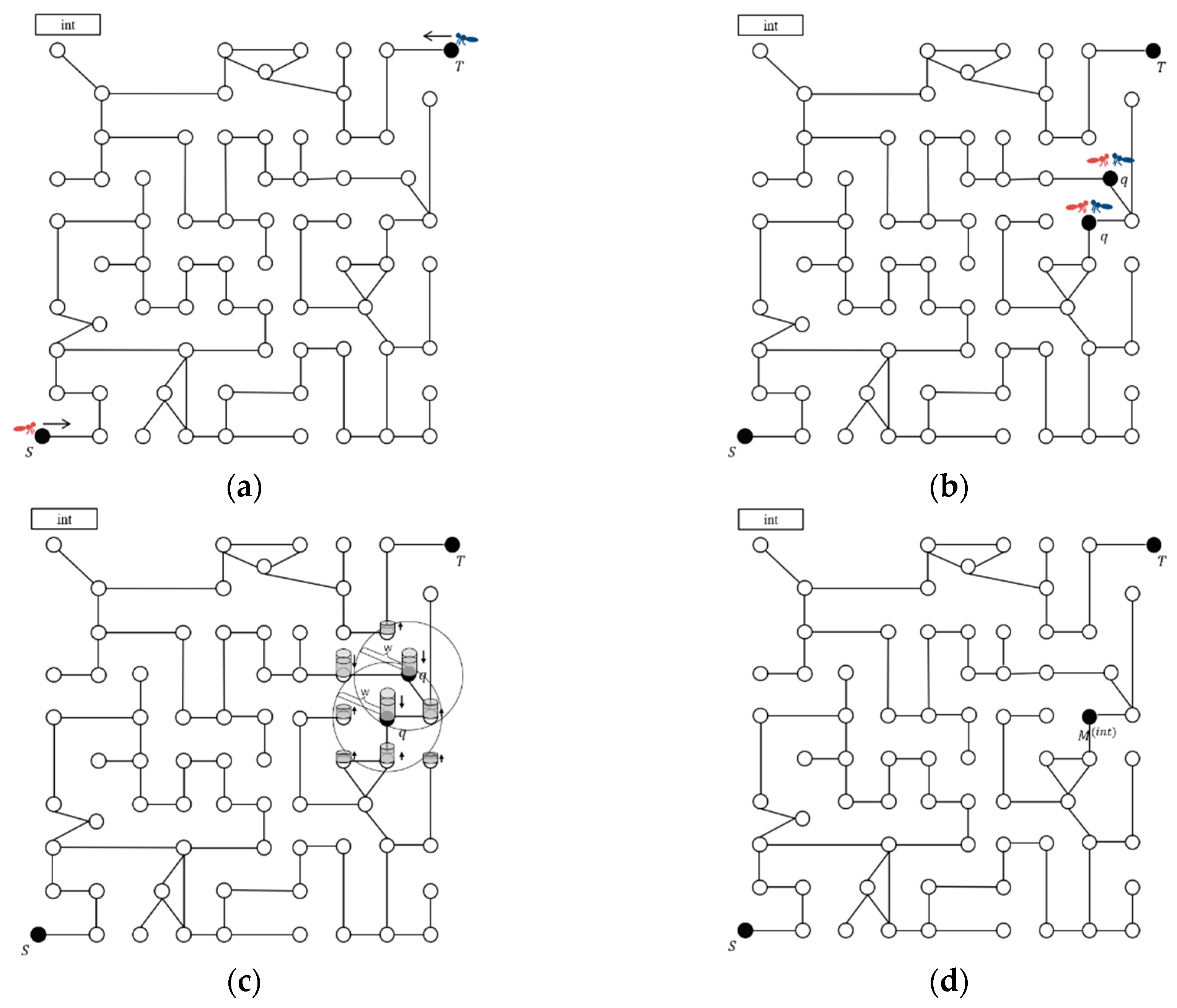
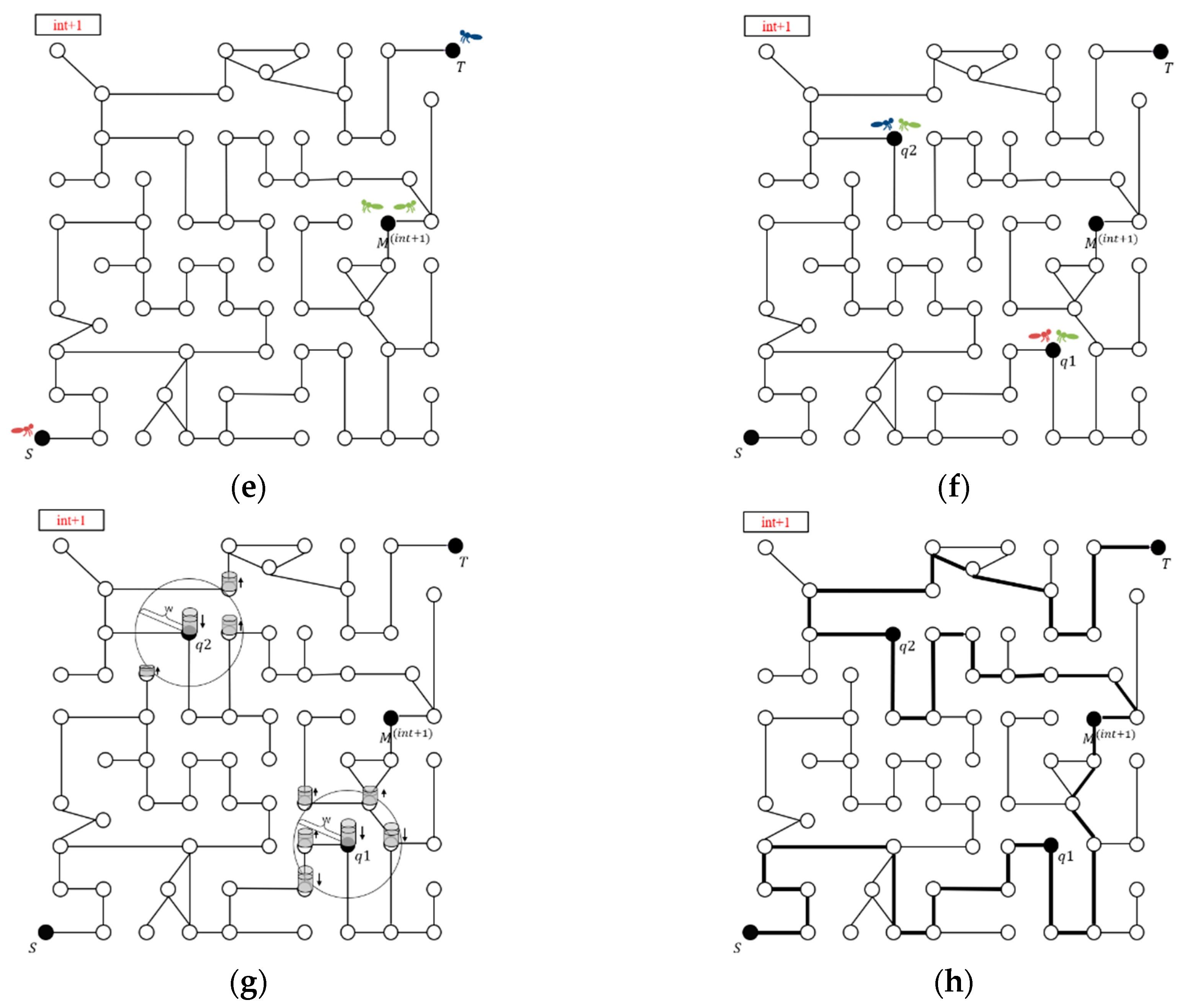
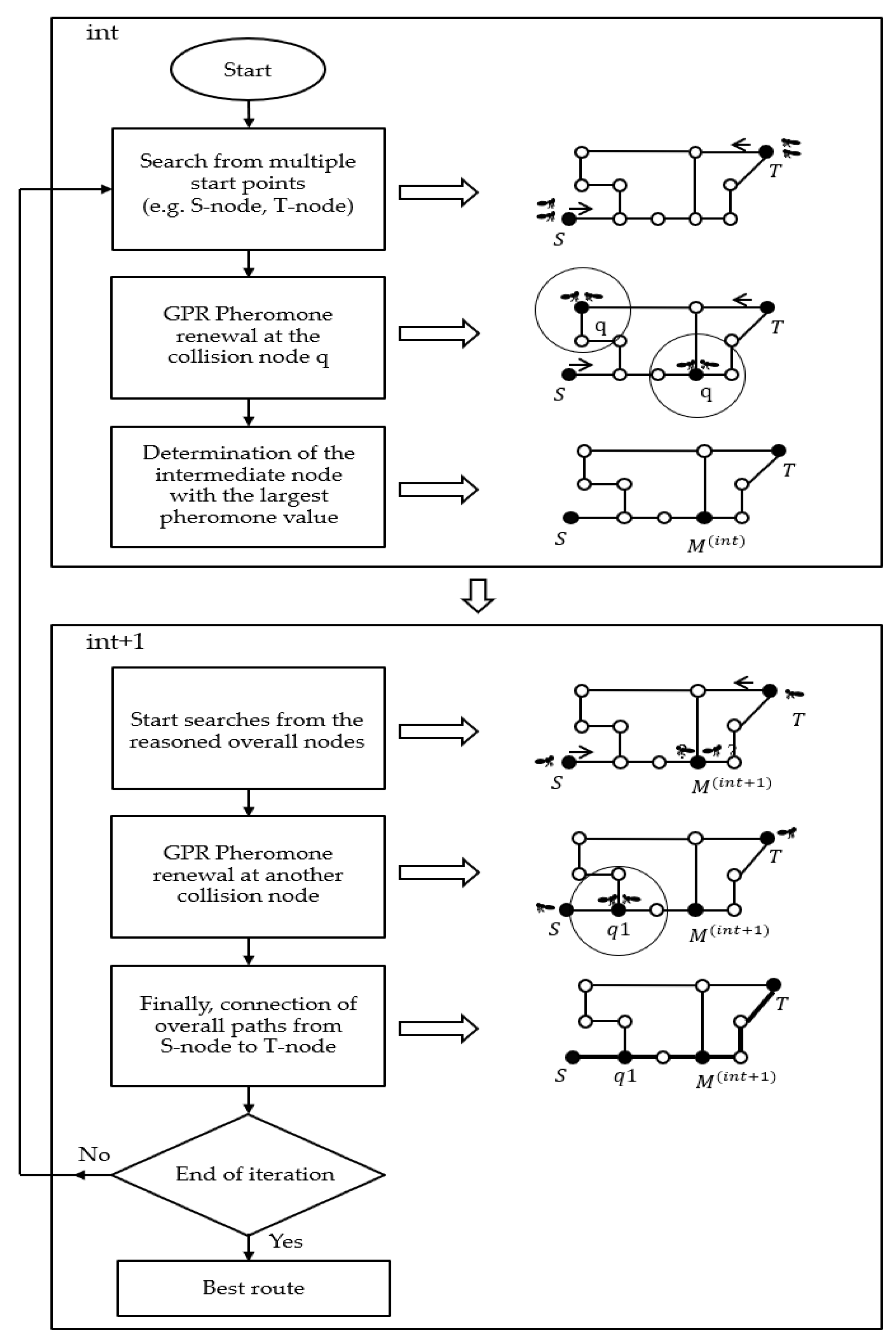
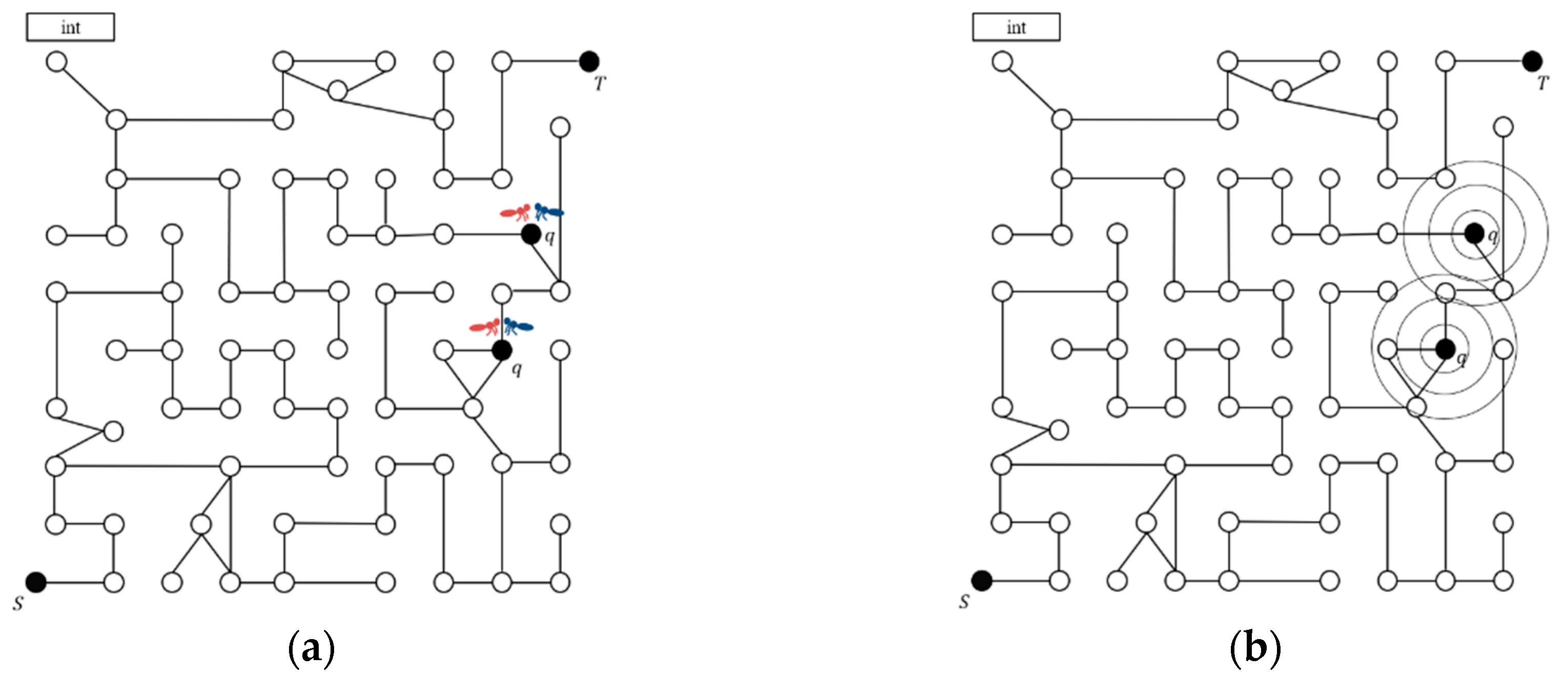
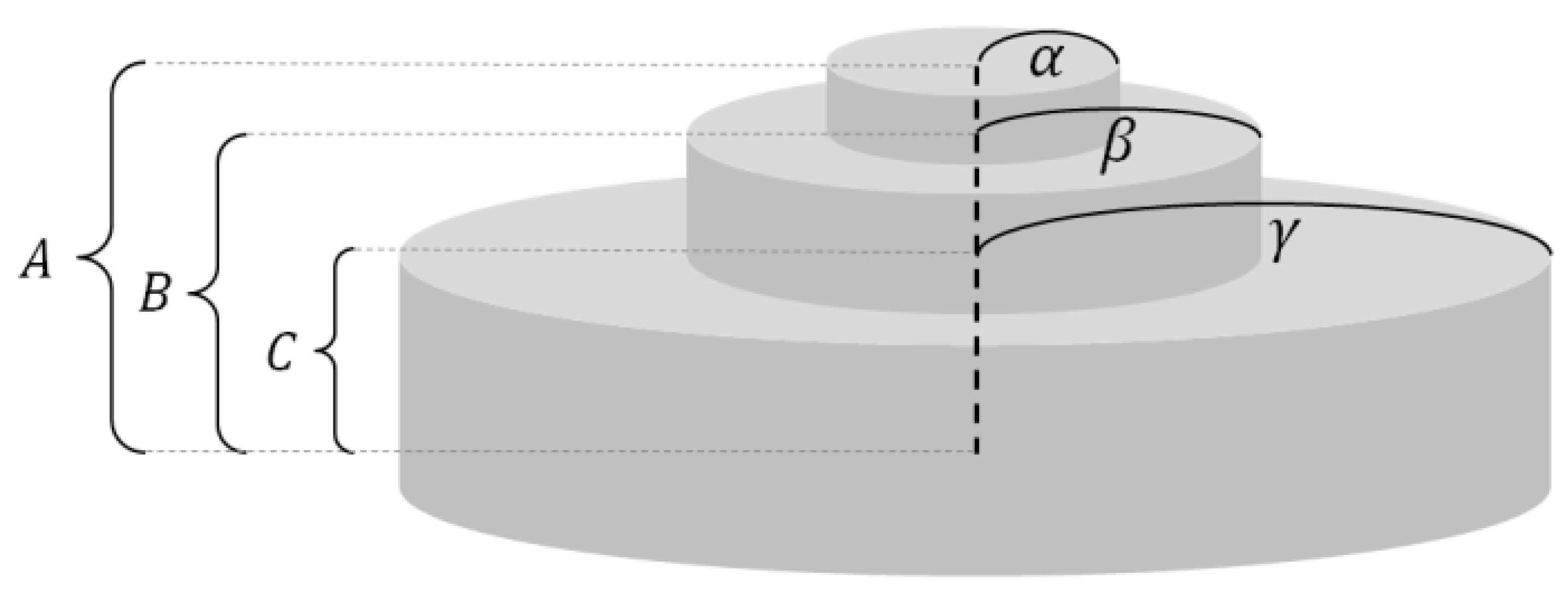

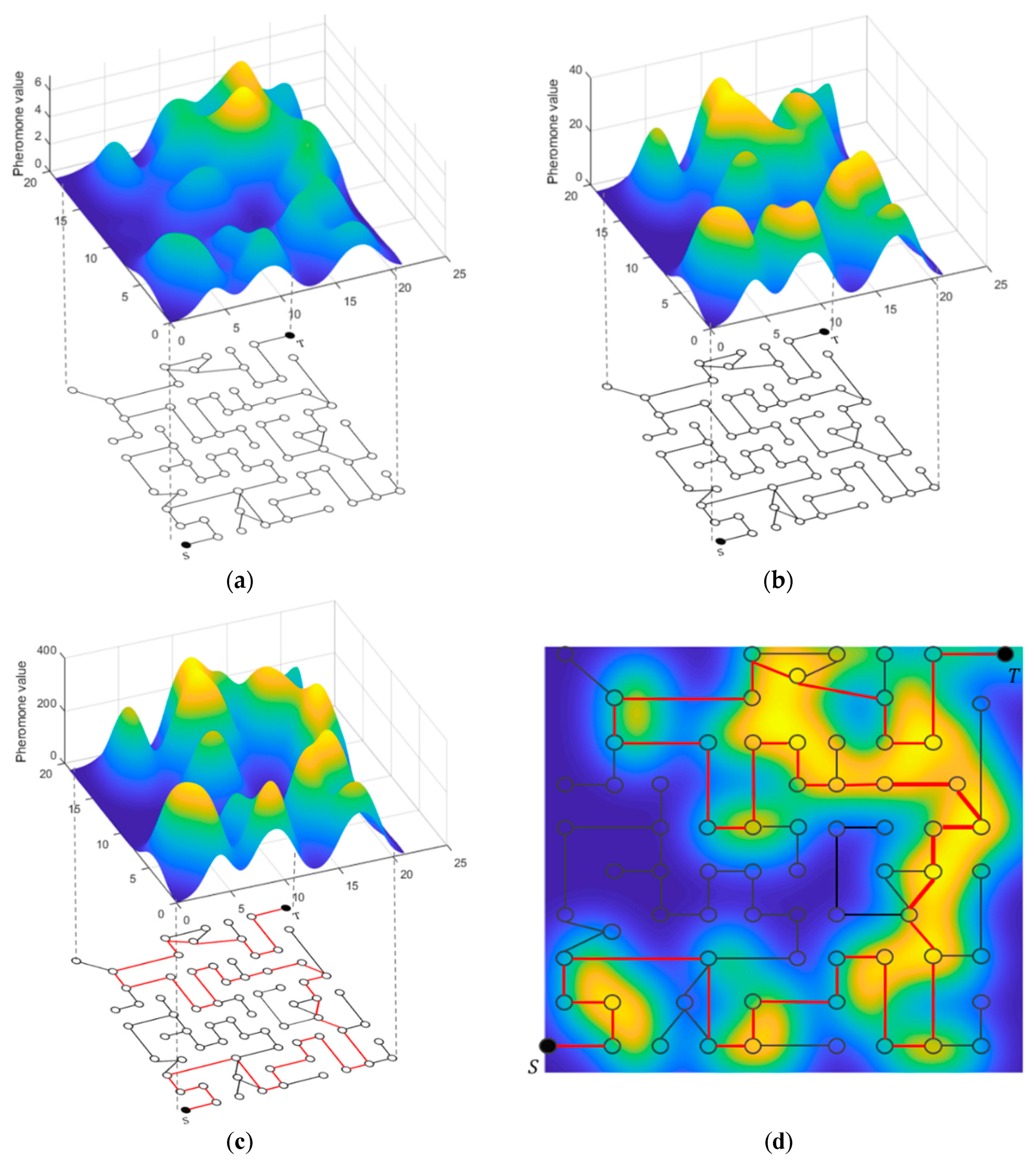
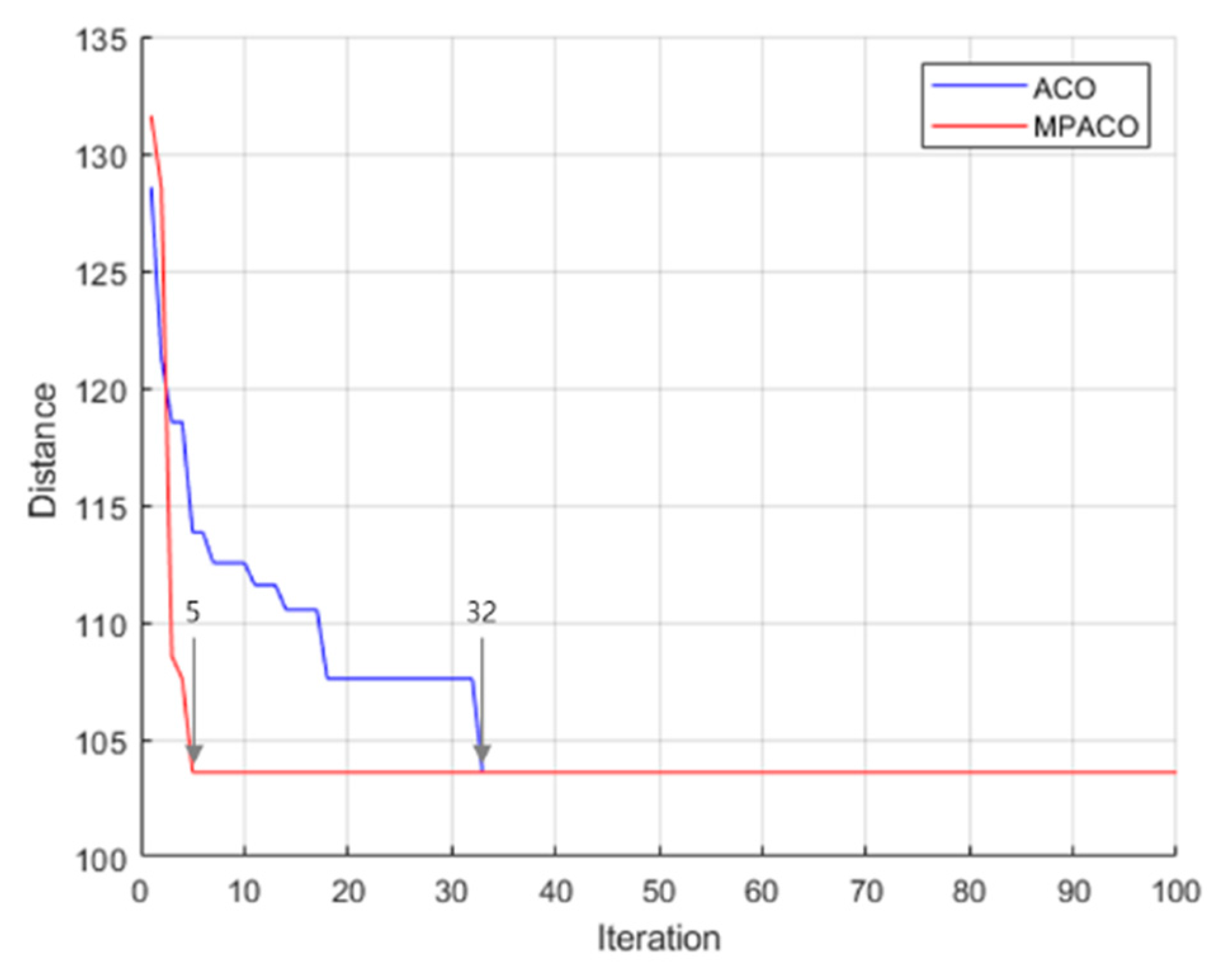
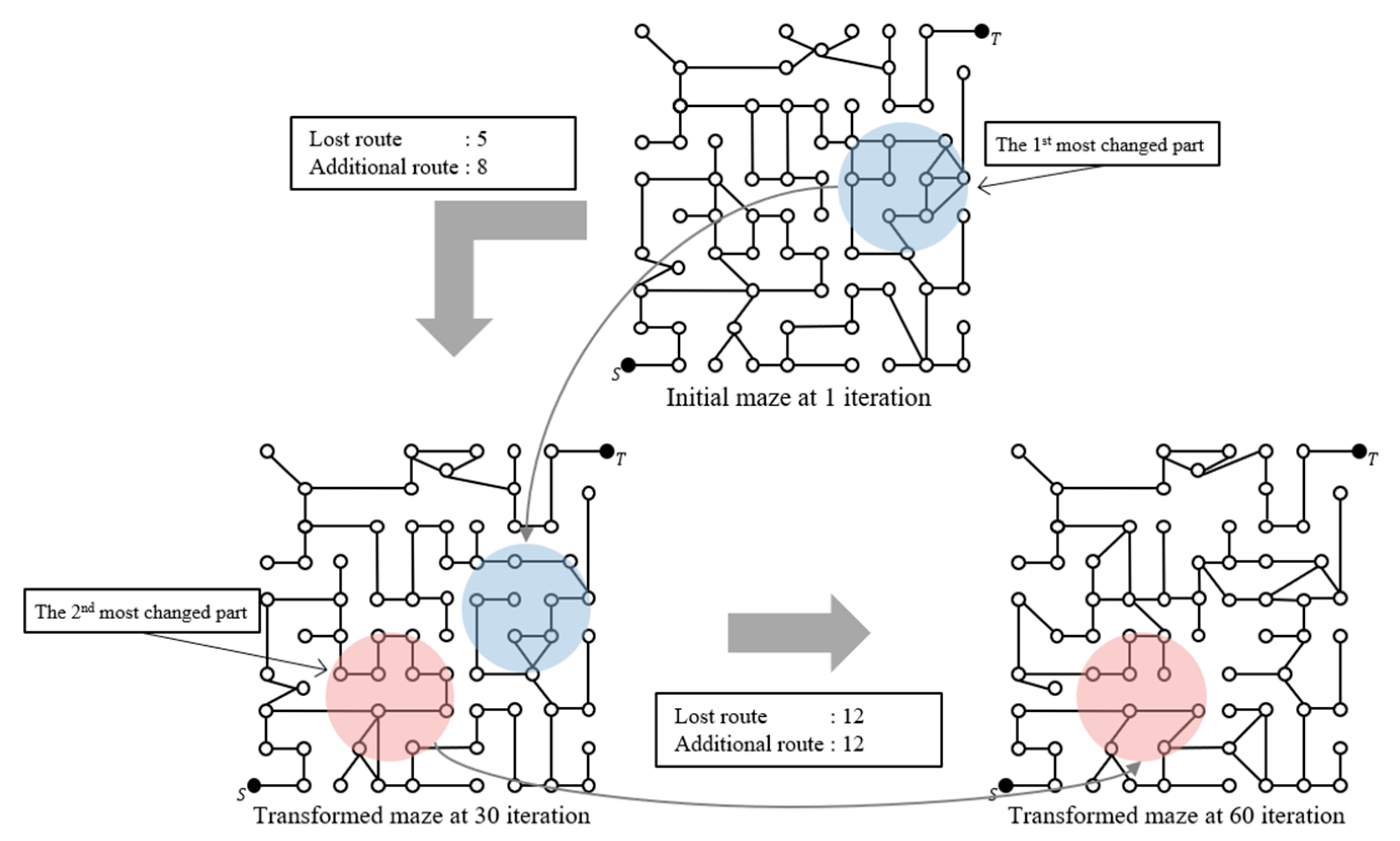
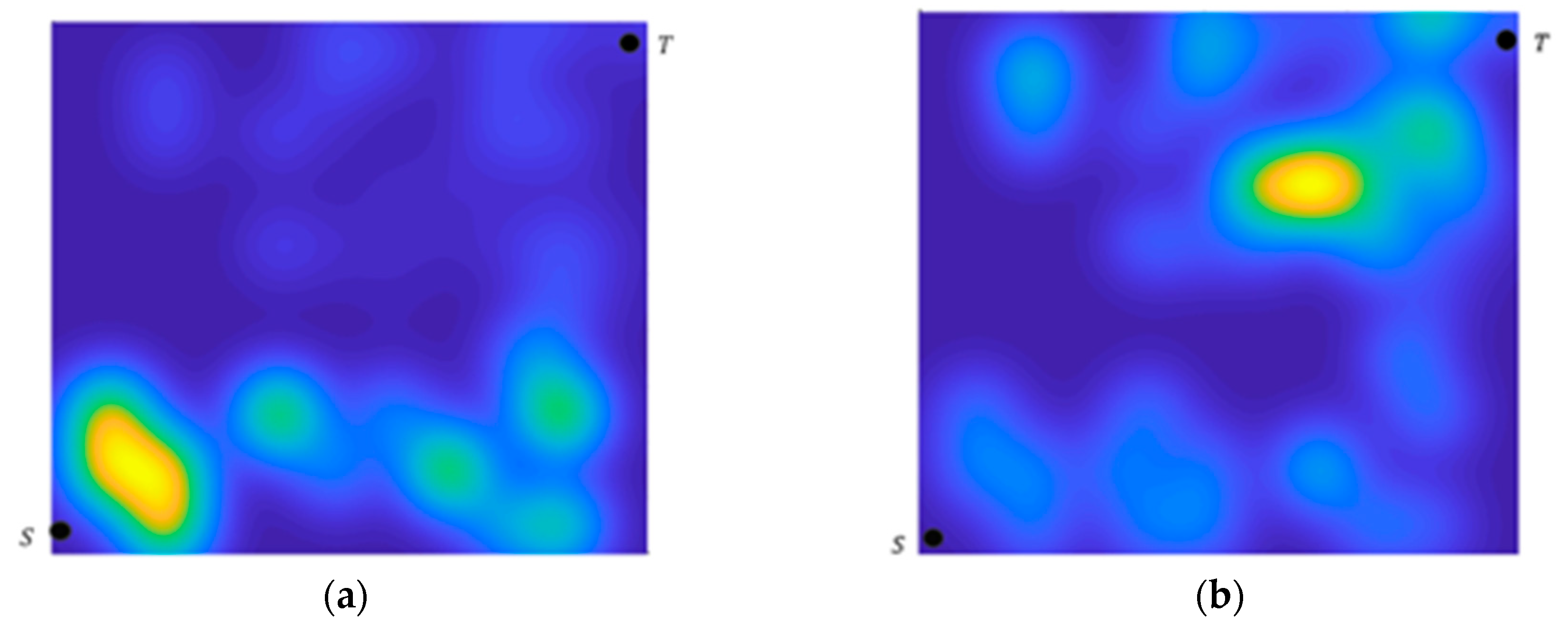

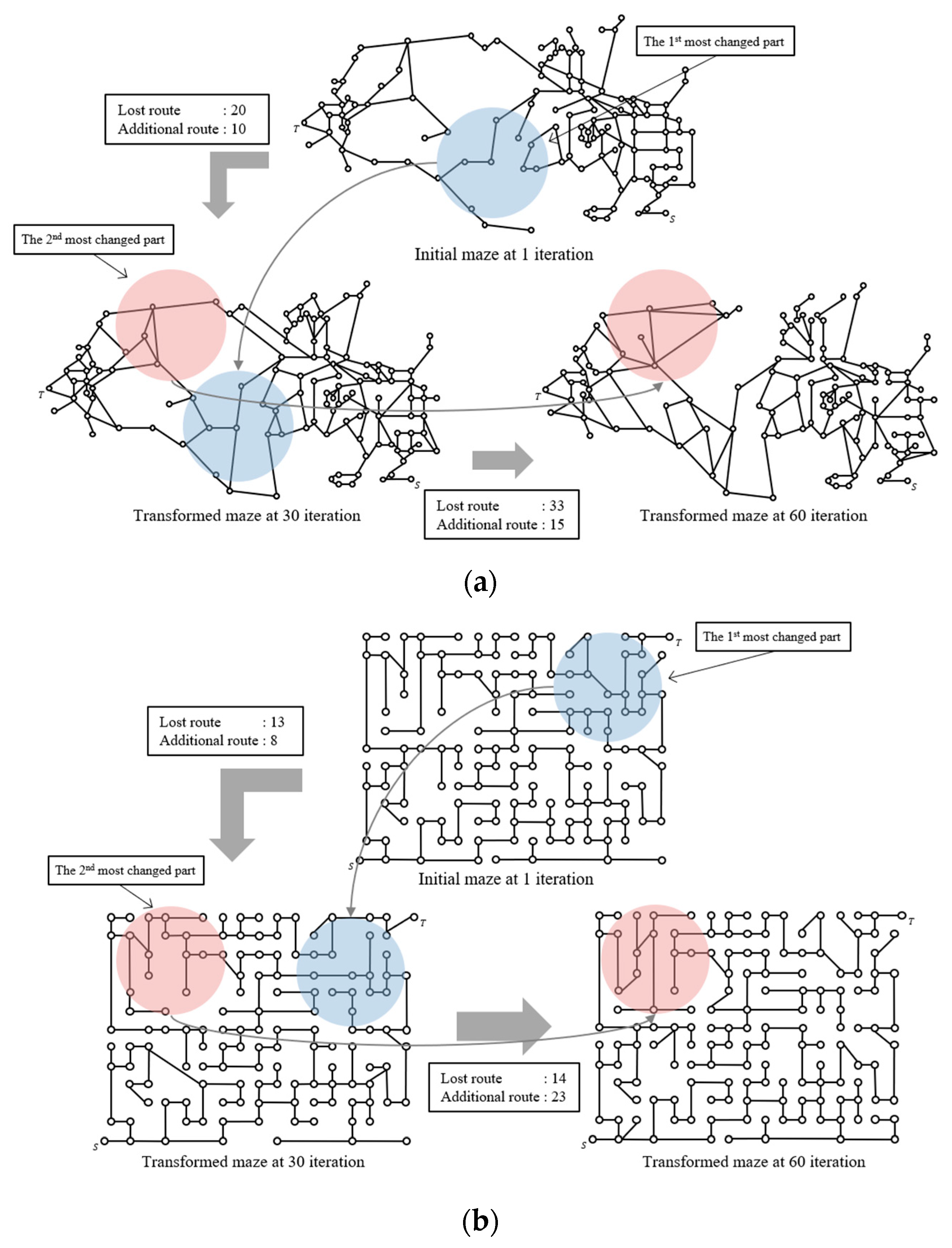
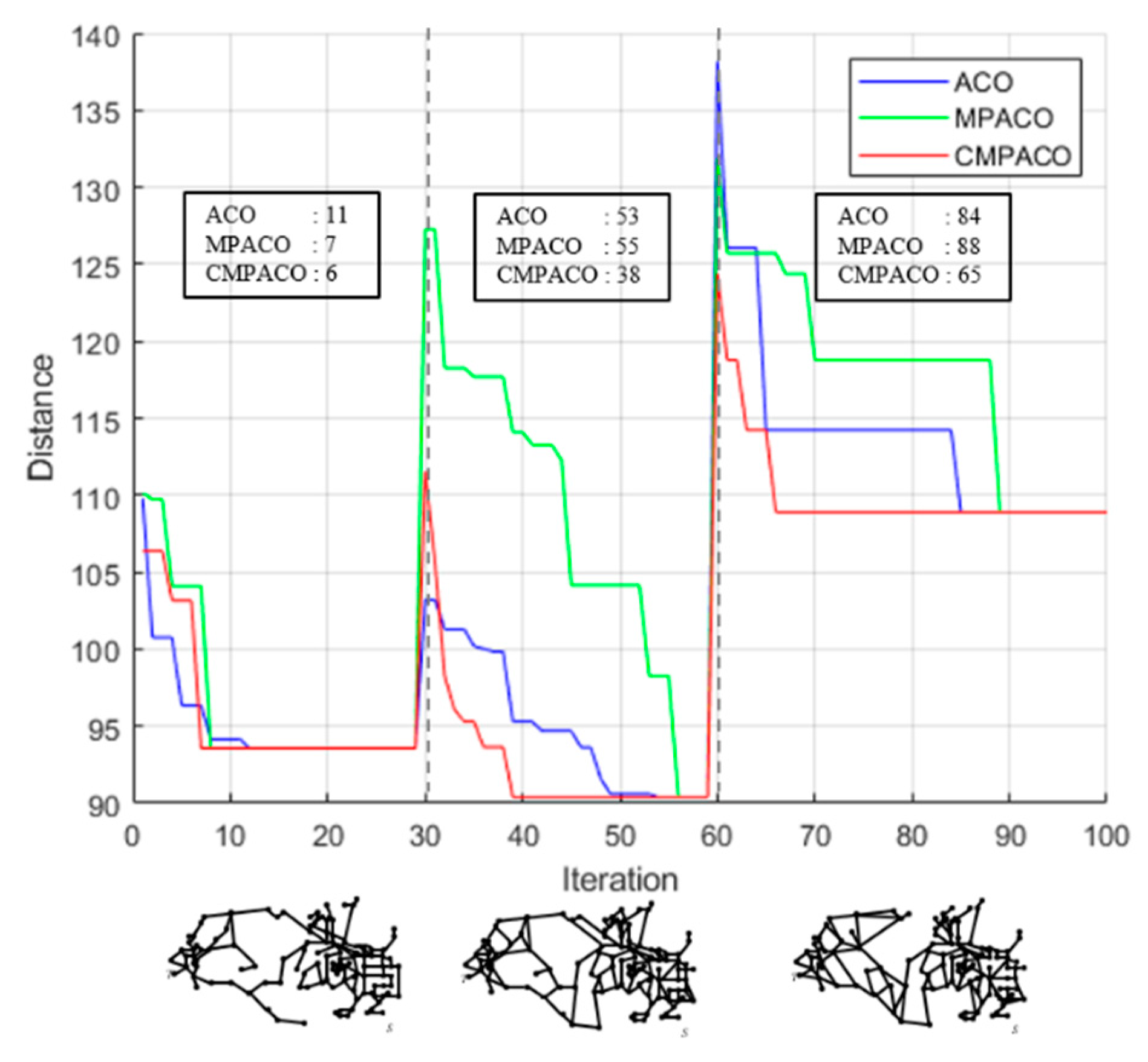
| Route Generation Based Research Studies | Applications and Characteristics |
|---|---|
| Garcia, Tria and Talampas [10] | Particle Swarm Optimization-based Energy efficient route generation to maximize vehicle mileage |
| Quang, Sanner, Morin and Aoul [11] | Route generation of large-scale networks using genetic algorithm |
| Yu, Liu, Liu, Hu, Zhang and Xiao [12] | Clustering routing algorithm based on glowworm swarm optimization |
| Xu, Wang and Sun [13] | Generation of efficient distributed model to reduce communication load using intelligent routing algorithm |
| Qiu, Zhong, Luo, Liu, Luo and Jiang [14] | Power distribution network routing generation using ACO |
| Research Studies Using ACO | Application Fields |
|---|---|
| Dorigo, Maniezzo, Colorni and Trubian [17]; Arnaout, Musa and Rabadi [18]; Chen, Lo, Wu and Lin [19] | Transportation and scheduling issues |
| Dorigo and Gambardella [20]; Oh and Lee [21] | Efficient route production |
| Ahmadizar, Barzinpour and Arkat [22] | Permutation flow shop scheduling problem |
| Dorigo, Maniezzo and Colorni [1] | Traveling salesman problem |
| Reza, Mahfujur, Abdur, Wail and Abdulmotaleb [23] | Wireless sensor network design |
| Maniezzo and Colorni [24] | The quadratic assignment problem |
| Research Studies Using GPR | Application Fields |
|---|---|
| Ak, Ergonul, Sencan, Torunoglu and Gonen [28] | The time and space prediction of an infectious diseases |
| Luttinen and Ilin [29] | Sea level temperature reconstruction |
| Nguyen and Peters [30] | Kinetics model estimation |
| Nguyen, Hu and Spanos [31] | Efficient building field formation by estimating indoor environment fields |
| Chen, Qian, Meng and Nabney [32] | Wind prediction for energy efficiency |
| ACO | MPACO | |
|---|---|---|
| Iterations | 1 | 1 |
| Computation speed (Agents’ Total Movement) | 70.64 | 61.64 |
| Research Studies on Dynamic Networks | Application Fields |
|---|---|
| Eklund, Kirkby and Pollitt [34] | Use dijkstra’s classic double bucket algorithm to find the network route |
| Giraldal, Rodriguez, Pernas, Higuera, Ortega and Zarzuela [35] | Intelligent system for transport fleet management |
| Noto and Sato [36] | Route search for car navigation systems using the extended dijkstra algorithm |
| Moss and Segall [37] | Optimal control theory to the problem of dynamic routing |
| Cauvery and Viswanatha [38] | Generate the shortest route applied ants algorithm and genetic algorithm |
| Type | Detailed Assumptions |
|---|---|
| Condition No.1 | The same number of ants is used in both ACO and MPACO tests. |
| Condition No. 2 | The locations for ant colony and food location are the same in each network for both cases. |
| Assumption No. 1 | When ants in different groups meet each other in a node, the ants stop moving. |
| Assumption No. 2 | When the ants reach the wall/block of the maze, they go back to find another route. |
| Variable | Value |
|---|---|
| Evaporation rate () | 0.5 |
| Initial pheromone () | 1 |
| Number of ant (AN) | 12 |
| Platform | Parameters |
|---|---|
| System Version | Windows 10 Pro. 64-bit |
| CPU | Intel(R) Core (TM) i7-4870HQ @ 2.50GHz |
| RAM | 16GB |
| Test Framework | Iteration | Computation Time |
|---|---|---|
| ACO | 32 | 19.16(s) |
| MPACO | 5 | 4.92(s) |
| Map | Iteration | Route Search Time | |
|---|---|---|---|
| ACO | MPACO | ||
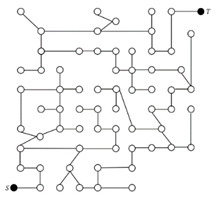 | 100 | 18.96(s) | 12.98(s) |
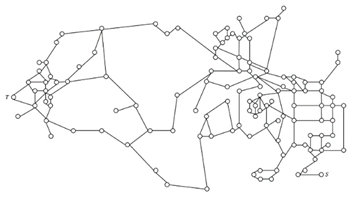 | 100 | 24.91(s) | 16.41(s) |
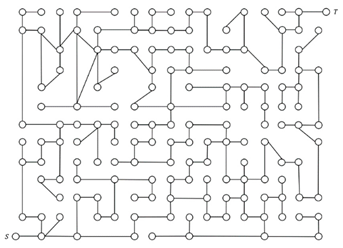 | 100 | 27.63(s) | 19.21(s) |
| Test Framework | Iteration | Computation Time (Unit: Seconds) |
|---|---|---|
| ACO | 100 | 17.15 |
| MPACO | 100 | 25.81 |
| CMPACO | 100 | 9.88 |
| Test Networks | Computation Time for the Best Result | ||
|---|---|---|---|
| ACO | MPACO | CMPACO | |
| Test network 1 | 15.82(s) | 17.33(s) | 10.45(s) |
| Test network 2 | 18.98(s) | 20.55(s) | 10.50(s) |
© 2019 by the authors. Licensee MDPI, Basel, Switzerland. This article is an open access article distributed under the terms and conditions of the Creative Commons Attribution (CC BY) license (http://creativecommons.org/licenses/by/4.0/).
Share and Cite
Oh, E.; Lee, H. Development of a Convolution-Based Multi-Directional and Parallel Ant Colony Algorithm Considering a Network with Dynamic Topology Changes. Appl. Sci. 2019, 9, 3646. https://doi.org/10.3390/app9183646
Oh E, Lee H. Development of a Convolution-Based Multi-Directional and Parallel Ant Colony Algorithm Considering a Network with Dynamic Topology Changes. Applied Sciences. 2019; 9(18):3646. https://doi.org/10.3390/app9183646
Chicago/Turabian StyleOh, Eunseo, and Hyunsoo Lee. 2019. "Development of a Convolution-Based Multi-Directional and Parallel Ant Colony Algorithm Considering a Network with Dynamic Topology Changes" Applied Sciences 9, no. 18: 3646. https://doi.org/10.3390/app9183646
APA StyleOh, E., & Lee, H. (2019). Development of a Convolution-Based Multi-Directional and Parallel Ant Colony Algorithm Considering a Network with Dynamic Topology Changes. Applied Sciences, 9(18), 3646. https://doi.org/10.3390/app9183646






